Global Finance unveils its annual list of the best global, regional and country banks.
By Gordon Platt
 Much has changed in the banking world over the past year—although not as much as might have been expected at the start of 2009. Many of the world’s leading banks have returned to profitability and repaid government bailouts. The industry is clearly in much better shape than it was a year ago, but there is still a tendency to hoard capital, and banks remain reluctant to lend, even to creditworthy borrowers. Meanwhile, banks continue to build up their loan-loss provisions in anticipation of more trouble down the road, as unemployment continues to rise in many countries despite an end to the global recession. Potential losses in credit cards and commercial real estate are still keeping some bankers awake at night.
Much has changed in the banking world over the past year—although not as much as might have been expected at the start of 2009. Many of the world’s leading banks have returned to profitability and repaid government bailouts. The industry is clearly in much better shape than it was a year ago, but there is still a tendency to hoard capital, and banks remain reluctant to lend, even to creditworthy borrowers. Meanwhile, banks continue to build up their loan-loss provisions in anticipation of more trouble down the road, as unemployment continues to rise in many countries despite an end to the global recession. Potential losses in credit cards and commercial real estate are still keeping some bankers awake at night.
Of course, conditions vary in markets around the world. Among emerging market banks, those in China and India have performed well, whereas those in Central and Eastern Europe are still struggling. Many of the smaller emerging markets that were initially isolated from the effects of the subprime mortgage crisis have been hit by the ensuing decline in global trade.
Some banks in developed markets have been successful in rebuilding their capital through rights offerings and the placement of shares. They are now in a position to take advantage of the opportunities that the financial crisis and recession have created. The US housing market, where the troubles began, is finally showing signs of recovery. Many issues remain to be sorted out, however, particularly the need for new regulations to prevent future financial crises.
In the United States, President Barack Obama has proposed to increase regulation and government oversight of the financial sector. The idea of a single banking regulator, however, seems to be making little headway. More likely, banks will be required to maintain higher levels of capital, and a new agency could be created to protect the interests of consumers using credit cards or taking out home mortgages.
In Europe, there is broad agreement that more needs to be done to monitor the financial system as a whole. The European Commission has proposed higher capital requirements for securitizations, as well as stronger disclosure requirements. It also wants to reform bank remuneration policies so that they do not encourage or reward excessive risk taking. National supervisory authorities would be called upon to enforce the new policies.
Many of the best-run banks were relatively unscathed by the financial crisis, as reflected by the number of repeat winners in this year’s survey, although the majority were forced to rely at least briefly on taxpayer funding.
Global Finance has identified the best banks in 123 countries, as well as the best banks globally in 11 key banking categories. We have been presenting these awards since 1997.
In selecting this year’s winners, Global Finance’s editorial team as usual considered factors that range from the objective to the informed subjective. Objective criteria included growth in assets, profitability, geographic reach, strategic relationships, new business development and product innovation. Subjective criteria included the opinions of equity and credit-rating analysts, banking consultants and others in the industry, as well as corporate and financial executives.
The winners are not always the biggest banks but rather the best banks—those with the qualities that corporations should look for when choosing a bank. These are banks with effective risk-management systems, excellent service and good corporate governance.
Within this listing of the World’s Best Banks we have included our April 2009 list of the Best Developed Market Banks and our May 2009 list of the Best Emerging Market Banks.
WORLD’S BEST BANKS 2009
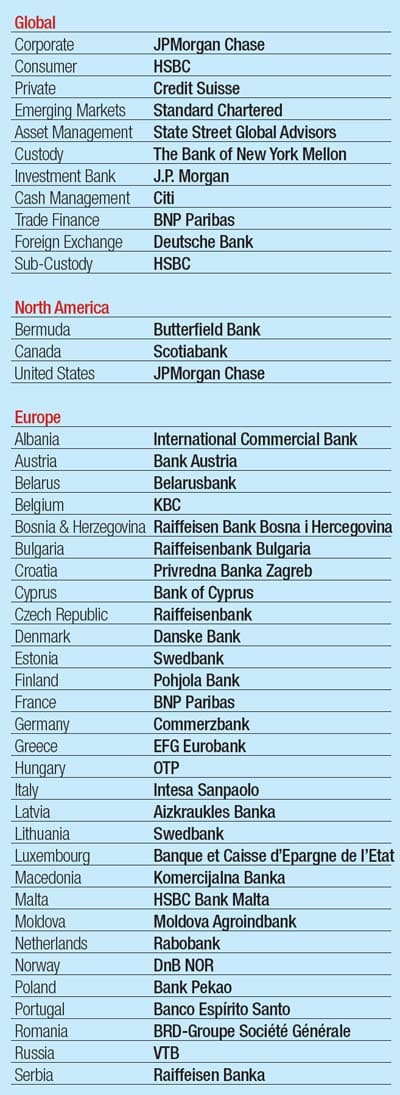
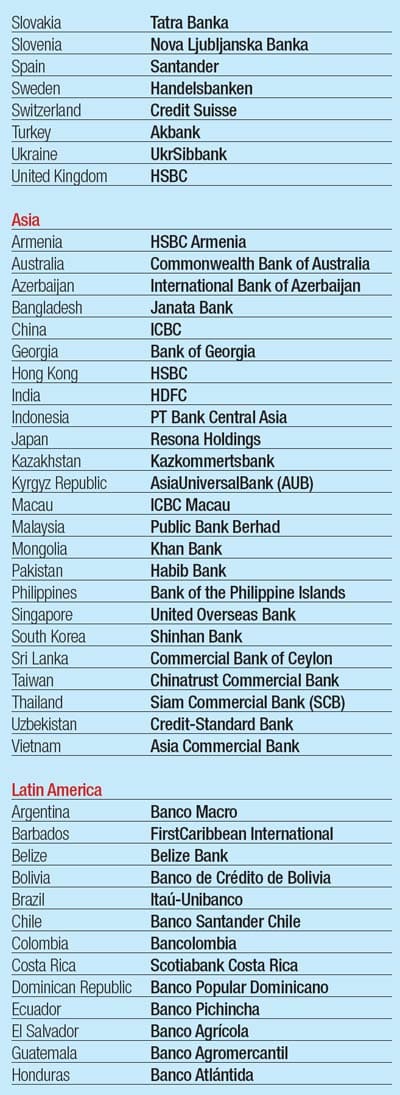
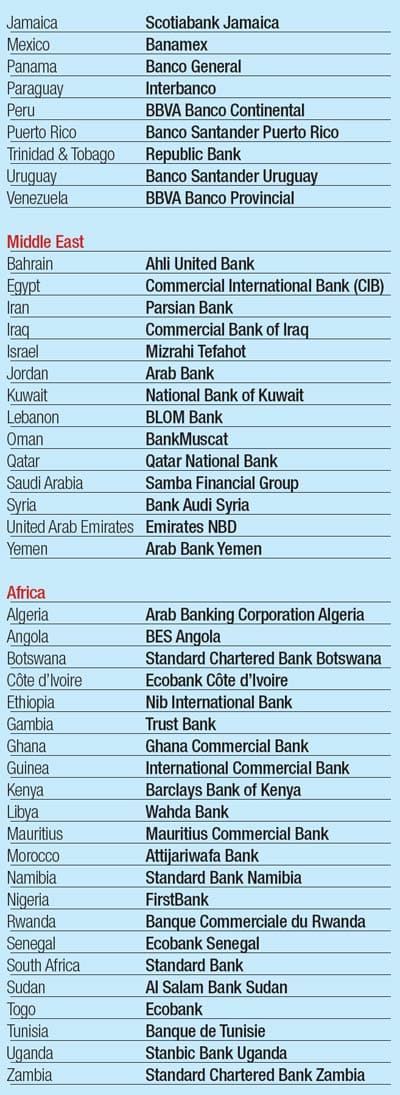
World’s Best Banks Global
Best Corporate Bank
JPMorgan Chase
If any bank can be said to have benefited from the global financial crisis, it is JPMorgan Chase. A major international bank with assets of over $2 trillion, it operates in 60 countries and serves many of the world’s major corporations, as well as tens of thousands of smaller and middle-market companies. Its investment bank, J.P. Morgan, was number one in worldwide debt and equity underwriting in the first half of 2009. It was ranked number three worldwide in advising on mergers and acquisitions. JPMorgan Chase’s profit of $2.7 billion in the second quarter was the first clear indication that the banking industry turned the corner. The well-capitalized bank has smoothly assimilated its acquisitions last year of Bear Stearns and Washington Mutual. One of the top commercial banks in market share, it offers a full range of services, including lending, treasury services and investment management. It is a leader in asset-based lending and equipment finance. Between its commercial bankers and its investment bank, JPMorgan Chase is capable of meeting the wide-ranging needs of its corporate customers, and it tailors its offerings to meet their specific requirements.
James Dimon, chairman and CEO
Best Consumer Bank
HSBC
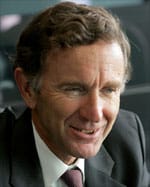 While its acquisition of US consumer lender Household International in 2003 was clearly a mistake, UK-based HSBC remains the world’s leading consumer bank, with an extensive presence in local markets, especially in Asia, where its roots are. The bank earned $5 billion in the first half of 2009, despite a sharp rise in non-performing loans as a result of the global recession. HSBC is conservatively managed, and it was not forced to take any bailout funds from the British government. The bank takes something of a cookie-cutter approach to its global operations, which ensures a standard level of service and access to sophisticated electronic platforms but detracts from its ability to specialize. It makes up for this in many cases, however, with its deep roots and knowledge of local markets. It serves 41 million people worldwide with a wide range of savings, investment and insurance products.
While its acquisition of US consumer lender Household International in 2003 was clearly a mistake, UK-based HSBC remains the world’s leading consumer bank, with an extensive presence in local markets, especially in Asia, where its roots are. The bank earned $5 billion in the first half of 2009, despite a sharp rise in non-performing loans as a result of the global recession. HSBC is conservatively managed, and it was not forced to take any bailout funds from the British government. The bank takes something of a cookie-cutter approach to its global operations, which ensures a standard level of service and access to sophisticated electronic platforms but detracts from its ability to specialize. It makes up for this in many cases, however, with its deep roots and knowledge of local markets. It serves 41 million people worldwide with a wide range of savings, investment and insurance products.
Stephen Green, group chairman
Best Private Bank
Credit Suisse
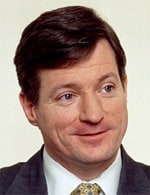 Credit Suisse reported a profit of $1.5 billion in the second quarter of 2009, an increase of 29% from the same period a year earlier, as it gained market share in many areas. Its private bank benefited from the problems at rival UBS, which has been involved in a long-running dispute with the US government over offshore tax avoidance. Credit Suisse also has benefited from growth at its investment banking business and its limited exposure to toxic assets related to the subprime mortgage market. The bank turned to Middle East investors to rebuild its capital instead of accepting money from the government. Credit Suisse boasts a high gross margin in wealth management and a solid net inflow of funds. Its retail business, however, has felt the effects of a weak economy, and the bank has been forced to sharply increase provisions for credit losses.
Credit Suisse reported a profit of $1.5 billion in the second quarter of 2009, an increase of 29% from the same period a year earlier, as it gained market share in many areas. Its private bank benefited from the problems at rival UBS, which has been involved in a long-running dispute with the US government over offshore tax avoidance. Credit Suisse also has benefited from growth at its investment banking business and its limited exposure to toxic assets related to the subprime mortgage market. The bank turned to Middle East investors to rebuild its capital instead of accepting money from the government. Credit Suisse boasts a high gross margin in wealth management and a solid net inflow of funds. Its retail business, however, has felt the effects of a weak economy, and the bank has been forced to sharply increase provisions for credit losses.
Credit Suisse is prepared to make acquisitions to expand its private-banking business. There could be opportunities for it to acquire smaller Swiss banks unable to compete in the stricter compliance environment. Credit Suisse is eager to serve more high-net-worth clients in Asia, which is expected to lead future growth.
Brady Dougan, CEO
Best Emerging Markets Bank
Standard Chartered
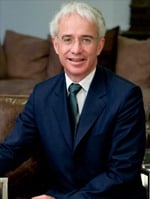 UK-based Standard Chartered earns 90% of its income and profits in Asia, Africa and the Middle East. It has 1,750 branches in 70 countries. The bank’s income rose 14% in the first half of 2009 to a record $8 billion, while its earnings rose 10% to a record $2.8 billion. Standard Chartered raised $1.6 billion through a share placement in August and is ready to take advantage of opportunities arising from the financial crisis. In July it completed the acquisition of the remaining 75% of the shares it did not already own in pan-African mergers and acquisitions advisory firm First Africa. In December 2008 Standard Chartered raised its stake to 74.9% in the India-based securities firm formerly known as UTI Securities. Standard Chartered plans to take full control of the firm by next year.
UK-based Standard Chartered earns 90% of its income and profits in Asia, Africa and the Middle East. It has 1,750 branches in 70 countries. The bank’s income rose 14% in the first half of 2009 to a record $8 billion, while its earnings rose 10% to a record $2.8 billion. Standard Chartered raised $1.6 billion through a share placement in August and is ready to take advantage of opportunities arising from the financial crisis. In July it completed the acquisition of the remaining 75% of the shares it did not already own in pan-African mergers and acquisitions advisory firm First Africa. In December 2008 Standard Chartered raised its stake to 74.9% in the India-based securities firm formerly known as UTI Securities. Standard Chartered plans to take full control of the firm by next year.
Peter Sands, group CEO
Best Asset Management Bank
State Street Global Advisors
State Street Global Advisors (SSgA), the investment management arm of Boston-based State Street, is the world’s largest manager of institutional assets and one of the largest providers of exchange-traded funds (ETFs) in the United States and globally. SSgA manages more than $290 billion for 66 central banks and government clients. As of June 30, 2009, the firm had $1.6 trillion in assets under management. US assets under management for Standard & Poor’s depositary receipt (SPDR) ETFs totaled more than $143 billion. SSgA’s parent, State Street, announced a loss of $3.3 billion in the second quarter of 2009 as it consolidated its asset-backed commercial paper conduits onto its balance sheet. State Street passed the Federal Reserve’s stress test in May and conducted a successful equity and debt offering. It also repaid US government investments under the Troubled Asset Relief Program.
Scott Powers, president and CEO
Best Custody Bank
The Bank of New York Mellon
 The Bank of New York Mellon is the world’s biggest custody bank, with more than $20 trillion in assets under custody and administration. The bank reported a 43% decline in earnings to $176 million for the second quarter from the same period a year ago, after repaying the $3 billion it received last year as part of the US government’s Troubled Asset Relief Program. The bank’s overall revenue has stabilized, and it continues to gain market share and remain profitable. It is still feeling the effects of the housing crisis, however, with investment losses on residential mortgage-backed securities. The Bank of New York Mellon operates in 34 countries and 100 markets. In June it celebrated its 225th anniversary.
The Bank of New York Mellon is the world’s biggest custody bank, with more than $20 trillion in assets under custody and administration. The bank reported a 43% decline in earnings to $176 million for the second quarter from the same period a year ago, after repaying the $3 billion it received last year as part of the US government’s Troubled Asset Relief Program. The bank’s overall revenue has stabilized, and it continues to gain market share and remain profitable. It is still feeling the effects of the housing crisis, however, with investment losses on residential mortgage-backed securities. The Bank of New York Mellon operates in 34 countries and 100 markets. In June it celebrated its 225th anniversary.
Robert Kelly, chairman and CEO
Best Investment Bank
J.P. Morgan
J.P. Morgan’s government-assisted acquisition of Bear Stearns in March 2008 provided it with a raft of new talent that has helped it to rise to the top in investment banking. J.P. Morgan ranked first for global debt underwriting for the first half of 2009, with $318 billion of issues. The bank showed continued strength in investment-grade and agency underwriting, according to Thomson Reuters. The bank also led first-half equity and equity-related rankings, with $53.5 billion in proceeds and a strong increase in market share. J.P. Morgan ranked third in global mergers and acquisitions advisory work in the first half, behind Goldman Sachs and Morgan Stanley.
Steven Black and William Winters, co-CEOs of investment banking
Best Cash Management Bank
Citi
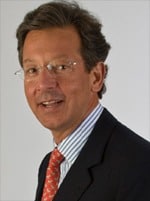 Citi’s Global Transaction Services unit provides treasury and trade services, as well as securities and fund services. The bank’s Treasury Vision and Online Investment platform continues to set the standard when it comes to integrating online cash management, investment and web-based treasury management. The bank operates in 140 countries and is able to deliver economies of scale. Citi reported earnings of $4.3 billion for the second quarter of 2009, but this included a $6.7 billion after-tax gain associated with the Morgan Stanley Smith Barney transaction, which created a joint venture brokerage firm. Citi’s headcount declined by about 30,000 from the first quarter of 2009, to 279,000, mainly reflecting the Smith Barney deal.
Citi’s Global Transaction Services unit provides treasury and trade services, as well as securities and fund services. The bank’s Treasury Vision and Online Investment platform continues to set the standard when it comes to integrating online cash management, investment and web-based treasury management. The bank operates in 140 countries and is able to deliver economies of scale. Citi reported earnings of $4.3 billion for the second quarter of 2009, but this included a $6.7 billion after-tax gain associated with the Morgan Stanley Smith Barney transaction, which created a joint venture brokerage firm. Citi’s headcount declined by about 30,000 from the first quarter of 2009, to 279,000, mainly reflecting the Smith Barney deal.
Francesco Vanni d’Archirafi, head of global transaction services
Best Trade Finance Bank
BNP Paribas
BNP Paribas is France’s largest bank and its leading provider of trade services such as letters of credit and bank guarantees. It operates a network of 93 trade centers around the world with teams of advisers who specialize in all aspects of international trade. BNP Paribas reported a 6.6% increase in second-quarter 2009 earnings, aided by the acquisition of Fortis assets and the much-improved performance of the corporate and investment bank. The French bank has acquired the Belgian and Luxembourg banking assets of Fortis, which was once Belgium’s leading financial services firm.
Baudouin Prot, CEO
Best Foreign Exchange Bank
Deutsche Bank
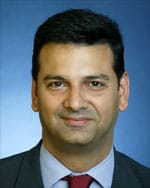 Frankfurt-based Deutsche Bank, Germany’s biggest bank, is the world’s leading provider of foreign exchange services. According to Connecticut-based Greenwich Associates, Deutsche Bank’s market penetration has reached 73% of the most-active users of foreign exchange products worldwide. The bank’s second-quarter earnings rose 67% from a year earlier to $1.6 billion, as its investment banking business stabilized. Its trading businesses were strong, including foreign exchange, money markets and interest rate trading. The bank is active in financial markets in 80 countries. Deutsche Bank’s FX4Cash product offers cross-border payment services.
Frankfurt-based Deutsche Bank, Germany’s biggest bank, is the world’s leading provider of foreign exchange services. According to Connecticut-based Greenwich Associates, Deutsche Bank’s market penetration has reached 73% of the most-active users of foreign exchange products worldwide. The bank’s second-quarter earnings rose 67% from a year earlier to $1.6 billion, as its investment banking business stabilized. Its trading businesses were strong, including foreign exchange, money markets and interest rate trading. The bank is active in financial markets in 80 countries. Deutsche Bank’s FX4Cash product offers cross-border payment services.
Zar Amrolia, global head of foreign exchange
Best Sub-Custody Bank
HSBC
HSBC is a leading provider of sub-custody services to international investors in 39 markets worldwide. It is the only bank providing sub-custody and clearing services in many of these markets, which it entered as soon as foreign investors were allowed in. HSBC uses its knowledge of local markets to support its customers’ operations in many emerging markets. It offers information services to keep them abreast of changes in market structures and other developments. As a sub-custodian, HSBC provides custody, clearing and various types of securities services to global custodians, fund managers, brokers, dealers and institutions worldwide. It is responsible for the safekeeping of $2 trillion in client assets.
Stephen Green, group chairman
World’s Best Banks North America
Bermuda
Butterfield Bank
Celebrating 150 years of operation in 2008, Butterfield Bank remains Bermuda’s largest independent bank, offering a full range of community banking services, as well as international financial services such as private banking, asset management and personal trust services. Butterfield was busy in its anniversary year, with the completion of a merger between Butterfield Fund Services and the Fulcrum Group to form a new Bermuda-based company, Butterfield Fulcrum Group (BFG), in September 2008. The deal put the new group in the top-10 of global alternative asset fund administration companies.
As well as being strategically advantageous, the creation of BFG also delivered a one-time gain of $115.5 million in the third quarter of 2008. Butterfield admirably wrote down $29.2 million on previously capitalized investments in technology as part of a migration of its core information and technology systems to a common information technology platform. This move is due to be completed in 2010 and is likely to be more than offset over the medium term through operational savings from systems duplication and licensing fees, and will enhance customer services.
Alan Thompson, president and CEO
Canada
Scotiabank
Along with banks in almost all developed markets, Canada’s leading banks—Royal Bank of Canada and Scotiabank—had a tough fourth quarter (which ended October 31, 2008). Based on that quarter alone, RBC would likely be judged the better bank of the two. Scotiabank’s earnings per share (EPS) fell by a catastrophic 70.5% while RBC’s dropped a more moderate 19.8%. Similarly, Scotiabank’s net income was down by 66% compared to a 15% fall at RBC. And Scotiabank’s return on equity (ROE) was a pitiful 6% compared to RBC’s 16.1%.
However, over the full year the two banks are more evenly matched, with Scotiabank suffering a 23.9% fall in EPS versus 19.33% at RBC and a 22% slump in net income versus a 17% fall at RBC. Moreover, their ROEs are evenly matched at 17% for Scotiabank and 18% for RBC.
Scotiabank is this year’s winner for a number of reasons. First of all, its five-year ROE enjoys a commanding lead over RBC. And, second, Scotiabank’s core business in Canadian banking, international banking and Scotia Capital continues to look strong: Excluding the $642 million write-down related to the Lehman Brothers bankruptcy and valuation adjustments, net income for the fourth quarter was flat on the previous year—a remarkable achievement given market conditions.
Rick Waugh, president and CEO
United States
JPMorgan Chase
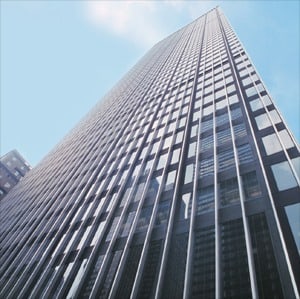 |
|
|
A year ago Goldman Sachs looked like one of the strongest banks on Wall Street following a series of successful calls on the subprime crisis; it was a serious contender for best bank in the United States and was only narrowly beaten by JPMorgan Chase. Now Goldman Sachs and Morgan Stanley have given up their investment bank status (in September 2008, to get access to federal funds) and are rapidly trying to develop broader business models that look remarkably like that of JPMorgan Chase.
JPMorgan Chase has looked like a winner throughout the crisis. To be sure, it has received $25 billion from the Troubled Asset Relief Program. But it also reported a fourth-quarter profit of $702 million. Moreover, JPMorgan Chase has received what looks like official recognition of its survivor status: In castigating some banks for their foolish policies, President Barack Obama specifically cited JPMorgan Chase and its chief executive, Jamie Dimon, as examples of good management during the crisis.
James Dimon, chairman and CEO
World’s Best Banks Europe
Albania
International Commercial Bank
Few banks were able to increase their return on equity in 2008, but International Commercial Bank was an exception: ROE reached 10.67% last year compared to 9.72% a year earlier. While non-performing loans (NPLs) grew to 5.81% from 5.03% in 2007, they remained well below 2006’s 12.53%. Moreover, there is every hope that International Commercial Bank has learned from its experience in 2006: Lending growth has been kept to sustainable levels—the loan portfolio grew by 23.6% in 2008—while income growth from other areas of the bank has been impressive. Income from remittances grew by 14.58%, income from treasury operations—a particularly lucrative and attractive area of banking, given its recurring revenues—grew by 68%, and income from foreign exchange rocketed by 179%. At the same time, International Commercial Bank has put customer satisfaction at the heart of its offering, with new products such as a Senior Citizens Deposit Scheme as well as new micro-lending offerings broadening the bank’s product base.
Mahendra Singh Rawat, CEO
Austria
Bank Austria
Earlier this year the storm clouds were certainly gathering for the UniCredit Group. After reporting a decline of 57% in Q4 2008 net profits, UniCredit said it would seek up to €4 billion in government funds from Italy and Austria in order to boost capital. With the economic environment in Central and Eastern Europe rapidly deteriorating, 2009 looked like it could be challenging. However, in the first six months of this year, Bank Austria’s operating profit was €2 billion, an increase of 50% on the corresponding period a year ago. Moreover, consolidated profit for the first nine months of 2008 was €1.64 billion—slightly higher than the previous year’s level. And while the bank looks to be seeking additional capital, it has already raised €6 billion through a rights issue and innovative convertible bond offering.
Erich Hampel, CEO
Belarus
Belarusbank
With the Belarus economy taking a sharp turn for the worse—the country is a recipient of IMF loans—conditions are getting tougher for banks. However, 2008 was a vintage year for state-owned Belarusbank, which is by far the largest financial institution in the country and the bedrock of the economy. Assets grew by a staggering 160.5% and net profit by 74.4%. Moreover, loan and deposit growth—at 147.1% and 149.6%—have been evenly matched, which could prove a significant factor in weathering worsening economic conditions. Indeed, with a market share of 49% for customer deposits, there is no bank better placed to weather the downturn than Belarusbank.
Despite its overwhelming dominance of the local market, Belarusbank has not rested on its laurels. The bank continues to innovate and in 2008 launched Internet banking and enhanced the functionality of its ATM network: Customers can now not only make payments but also buy railway tickets and even check lottery results.
Nadezhda Ermakova, chairperson of the board
Belgium
KBC
Belgium’s banking sector is well and truly battered: The country’s largest bank, Fortis, has been split up following the farrago of its acquisition of some assets of ABN AMRO (in a competition for worst-run bank of 2008, Fortis would run a close second to the UK’s RBS, which was also involved in the debacle). Meanwhile, one of Belgium’s other large banks, Dexia, has also had to go cap in hand to the government. In such company, KBC shines as the healthiest bank in a sick banking sector. To be sure, the bank has received two injections of capital from the government: In October 2008 €3.5 billion was received as the bank crisis reached its peak, while in January this year a further €3.5 billion was pledged after the bank’s shares lost more than 70% of their value. But while KBC announced an annual loss of almost €2.5 billion for 2008—in the fourth quarter alone there was a net loss of €2.63 billion—there is evidence that the bank has successfully reduced its risks. Moreover, given the capital injections, the financial position of KBC looks solid, and underlying business performance is improving: January 2009 was a better month than January 2008.
André Bergen, CEO
Bosnia & Herzegovina
Raiffeisen Bank Bosna i Hercegovina
While Raiffeisen Bank Bosna i Hercegovina is only the second-largest bank in Bosnia and Herzegovina by assets—the first is Hypo Alpe Adria—it is the most profitable. Moreover, Raiffeisen Bank is growing fast: At the end of 2008 assets were 12.4% higher than a year earlier. Corporate banking performed strongly in 2008 for Raiffeisen Bank. Its network of regional corporate business centers and emphasis on constant service quality improvement helped to grow the loan portfolio by 34%, while the trade finance portfolio rose by 15%. The performance is all the more impressive given the slowdown in lending recorded in the second half of 2008. Sensibly, the bank has already introduced more stringent lending policies.
Meanwhile, Raiffeisen Bank’s retail loan book grew by 20% in 2008, and its total number of issued debit, credit and charge cards (both for individuals and for businesses) grew by 37% in 2008 to 325,000.
Michael Müller, CEO
Bulgaria
Raiffeisenbank Bulgaria
With the outlook for the Bulgarian economy looking bleak, having already received funds from the IMF since the beginning of the year, Raiffeisenbank Bulgaria’s achievement of a 22% increase in profit after tax in 2008 is significant. Just as important, the bank substantially increased already large provisions for impairment losses, reflecting its conservative approach to risk management and building an important buffer for the future.
Moreover, while loan growth over the year reached 27%—an impressive figure but one that might elicit concern in the current environment—deposit growth has also been strong at 22% compared to just 7.5% in the banking market overall. With a capital base of 10.78% of the Bulgarian bank system’s capital (compared to 8.61% at the end of 2007) and total capital adequacy of more than 17% (significantly above the prescribed 12% and also above the average of 14.86% for the banking system), Raiffeisenbank Bulgaria has never looked stronger.
Momtchil Andreev, chairman and executive director
Croatia
Privredna Banka Zagreb
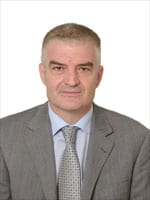 Privredna Banka Zagreb (PBZ) had a strong 2008 despite a sharp slowdown in economic growth in the fourth quarter (though not a recession, as growth stayed just positive at 0.2% year-on-year). In 2008 PBZ’s net profit rose an impressive 18% on the previous year, and the bank enjoyed 10% growth in loans to small and medium-size companies and 28% growth in the safer large-company and state-loans market.
Privredna Banka Zagreb (PBZ) had a strong 2008 despite a sharp slowdown in economic growth in the fourth quarter (though not a recession, as growth stayed just positive at 0.2% year-on-year). In 2008 PBZ’s net profit rose an impressive 18% on the previous year, and the bank enjoyed 10% growth in loans to small and medium-size companies and 28% growth in the safer large-company and state-loans market.
The bank appears to have paced itself during the good times and looks well positioned for a slowdown. By transferring its profit to retained earnings and by not paying out dividends, PBZ has maintained a high level of shareholders’ equity; consequently, it can boast a handsome capital adequacy ratio. Its strong showing in 2008 boosted that a further 2%.
Bozo Prka, president
Cyprus
Bank of Cyprus
Bank of Cyprus maintained high levels of profitability despite the negative international environment in 2008, with its conservative credit policy and selective growth strategy in new markets paying dividends. Group profit after tax for 2008 grew a moderate 4%, but, more importantly, return on equity was an impressive 25%. At the same time, total loans increased 29% compared to 2007, with the strongest growth outside the group’s core Cyprus and Greece markets. Deposits grew by 11% overall. Despite the apparent imbalance of loan and deposit growth, Bank of Cyprus has a strong loans-to-deposits ratio of 90% and minimal reliance on wholesale funding (13% of total funding). Moreover, despite the expansion of the group’s operations, the quality of its loan portfolio continued to improve, with the non-performing loans ratio decreasing to 3.7% from a year earlier. The bank may yet regret the timing of its acquisition of an 80% interest in Uniastrum Bank in Russia at the end of October 2008, but for the year under review it made a positive contribution to profit.
Andreas Eliades, group chief executive officer
Czech Republic
Raiffeisenbank
Raiffeisenbank enjoyed another record-breaking year in 2008, with net profit rising 39%—well above its main rivals—and all main segments performing well. The Czech Republic’s economy has been on a knife-edge in 2009 as industrial production slumped as a result of the collapse of global demand, but Raiffeisenbank has already taken precautionary measures, with a significant slowdown in lending toward the end of 2008. Mortgage sales, for example, were just a quarter of previous years while almost no long-term loans were made. At the same time, client deposits at the end of 2008 were up a fifth, with the strongest growth coming in the last two months of the year when both individuals and companies sought the perceived security of the Raiffeisenbank brand—a testament to the strength of the bank’s operation in the Czech Republic. Raiffeisenbank finalized its merger with eBanka, in which Raiffeisen International had acquired a majority in 2006, making it the fifth-largest bank in the Czech Republic.
Lubor Zalman, CEO
Denmark
Danske Bank
Denmark produced one of the first casualties of the credit crisis with the collapse of Roskilde Bank in August 2008, and the turmoil in the capital markets and the economic slowdown had a huge effect on Danske Bank’ s 2008 results. Net profit sank to just DKr1.0 billion ($170 million) compared to DKr14.9 billion ($2.53 billion) in 2007 following loan impairment charges of DKr8.8 billion. The group also had to make huge impairment charges on its loan portfolio in the plummeting Irish market, where it operates through National Irish Bank. Similarly, market-related activities—in Danske Markets, Danske Capital and Danica Pension—produced a miserable 2008.
Nevertheless, the group’s main source of income—its banking activities—proved robust and generated satisfactory results. Excluding the guarantee commission payable to the Danish state for participation in the guarantee scheme for deposits and loans, expenses were flat on 2007, and, crucially, at the end of 2008 the bank met its liquidity targets with a core tier-one capital ratio of 9.2%. By deleveraging its balance sheet, reducing non-lending assets and further improving liquidity management, Danske Bank should be able to weather whatever storms the remainder of 2009 delivers and be well placed to prosper once the economic environment improves.
Peter Straarup, CEO
Estonia
Swedbank
Estonia’s economy is in dire straits. It is set to shrink 10% this year and more than 2% in 2010. Such an environment is not propitious to successful banking. Moreover, Estonia—along with the other Baltic states, Latvia and Lithuania—was in trouble long before the global economic crisis took a turn for the worse in September and October 2008: All three countries were in recession in the first half of 2008, and Estonia’s GDP fell by 9.4% during 2008.
In the face of such challenges, Swedbank worked to improve efficiencies and coordinate product development and customer offerings across the Baltic region. In Estonia, lending increased by a moderate 6% in 2008, while loan losses from private customers and real estate management firms increased, maintaining Swedbank’s strong market position: It has 42% of the corporate lending market and 49% of the private loan market. Significantly, market share for deposits was 49%, giving Swedbank a level of stability that will prove important.
Priit Perens, head of Swedbank in Estonia
Finland
Pohjola Bank
When Pohjola Bank released its January-September 2008 figures, the immediate indication that all was not well was the concurrent announcement that the bank would launch a €300 million rights issue to recapitalize. Certainly, earnings before tax were lower, at €114 million compared to €220 million a year earlier, and EPS fell to €0.41 compared to €0.80.
However, the corporate loan portfolio and loan margins within the banking division showed sustained growth, and the operations posted good earnings. Moreover, Pohjola’s decision to come to market with a rights issue looks more like a prudent move and sound positioning for future opportunities rather than an emergency capital raising. At the end of 2008 Pohjola’s tier-one ratio was 9.6%—well above the bank’s own stated target of a minimum of 8.5% and the minimum regulatory capital requirement of 4%. Instead, the rights offering will further strengthen Pohjola’s capital base and secure its ability to provide credit in a market where the availability of financing has significantly decreased. And with capital adequacy now an important competitive edge between banks, by increasing its capital base Pohjola should be able to further increase its dominance in Finland.
Mikael Silvennoinen, president and CEO
France
BNP Paribas
BNP Paribas has profited handsomely from the calamity that crushed Belgium’s Fortis: The bank has become the eurozone’s largest deposit bank—a characteristic of supreme importance in the current market, where capital adequacy is all-important—and added two new domestic markets, Belgium and Luxembourg, to its European footprint. It is highly doubtful whether BNP Paribas would have been able to achieve such an outcome in normal market circumstances. But its ability to act quickly and garner the necessary resources was impressive.
Unsurprisingly, in 2008 the group’s revenues fell 11.8% on the previous year: The resilience of retail and asset management helped to limit the damage, generating returns on pre-tax allocated equity of 25% and 28%, respectively. Moreover, thanks to cost-cutting measures in all business units and a substantial reduction in bonuses, operating expenses fell 1.9% compared to 2007. Nevertheless, the downturn in the economy, in particular in the US, Spain and Ukraine, combined with numerous counterparty defaults in the financial markets, had a huge impact on the bank’s balance sheet. BNP Paribas has pledged to continue its de-risking process while redesigning its product offering to adapt it to customers’ needs. Only time will tell if its actions are enough to offset further weakness in some of its core markets.
Baudouin Prot, CEO
Germany
Commerzbank
Germany’s banking system is suffering—and that was before the economic disaster in Central and Eastern Europe, where Germany’s banks have expanded aggressively in recent years. The country’s largest bank, Deutsche Bank, posted its first full-year loss in 2008 (of €5.7 billion) in more than 50 years, after a catastrophic three months for its core investment banking business.
Commerzbank, the country’s second-largest bank, has also suffered but appears to have faced up to its problems sooner and acted more rapidly to solve them by taking €18.2 billion from the government in exchange for a 25% stake. In addition, Commerzbank has taken advantage of the crisis to acquire Dresdner Bank, broadening its franchise domestically and gaining access to new deposits.
For the full-year 2008 Commerzbank’s consolidated surplus attributable to its shareholders amounted to €3 million compared to €1.9 billion in 2007. Its operating loss for the year was €378 million, compared to an operating profit of €2.5 billion for the previous year (the operating loss for the fourth quarter was a shocking €822 million). However, excluding one-offs, the operating profit for 2008 remained positive at €2.1 billion. Moreover, Commerzbank’s operating earnings potential remained impressive in its core private- and business-customer franchises as well as in the crucial middle-market-company Mittelstand sector.
Martin Blessing, chairman and CEO
Greece
EFG Eurobank
In results released by EFG Eurobank, for the nine months to the end of September 2008, the worst of the financial and economic crisis had yet to be reflected; next year’s awards may tell a different story. Nevertheless, for the period under review, EFG Eurobank delivered healthy growth rates, enhanced its profitability and maintained high capital adequacy and sound liquidity—the result of prudent shareholder capital utilization and effective risk management.
For the first nine months of 2008, group net profit rose by 4.6% to €647 million despite the adverse conditions, while recurring profit grew by 17.9% to €560 million. Crucially, given the increased importance of capital adequacy, customer deposits increased by an impressive 42.5% on the same period a year earlier while capital adequacy was a sound 11%. Despite the strong growth in business, group operating expenses fell by 3.1% quarter-on-quarter. The challenge for EFG Eurobank is to respond to a new market environment. It is giving priority to the efficient utilization of capital, liquidity management and deposit gathering and adopting a more selective, prudent and proactive approach to risk.
Nicholas Nanopoulos, CEO
Hungary
OTP
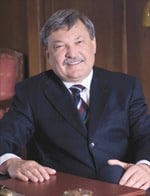 Hungary’s biggest banks—CIB, Erste, OTP, K&H; (owned by Belgium’s KBC) and Raiffeisen—endured mixed fortunes in 2008, as the country’s economy slid toward recession. While Erste managed an impressive 30.8% growth in after-tax profits, these awards are not just about profitability but instead also reflect the breadth of a bank’s offering, its track record of innovation and its scale.
Hungary’s biggest banks—CIB, Erste, OTP, K&H; (owned by Belgium’s KBC) and Raiffeisen—endured mixed fortunes in 2008, as the country’s economy slid toward recession. While Erste managed an impressive 30.8% growth in after-tax profits, these awards are not just about profitability but instead also reflect the breadth of a bank’s offering, its track record of innovation and its scale.
On that basis, OTP, by far the country’s largest bank, is a deserving winner, with after-tax profit four times that of Erste and the best cost/income ratio among the major banks (though not the best return on equity). OTP is an undisputed leader in all major segments of banking in Hungary with the exception of corporate lending (which will likely prove a fortuitous position as non-performing loans rise).
Sandor Csanyi, CEO
Italy
Intesa Sanpaolo
Italy, already one of the weakest economies in Western Europe, is widely predicted to suffer a 4% fall in GDP in 2009, putting further pressure on its banks. While UniCredit has sought €3 billion from investors, Intesa Sanpaolo has simply canceled its dividend, which it says will give it a core tier-one capital ratio of up to 8%—in line with other European banks that have received state investment. Only time will tell whether Intesa Sanpaolo’s frequent affirmations that it has never considered a capital raising—and will not need to—is hubris.
In the first nine months of 2008, Intesa Sanpaolo delivered a solid operating performance despite the unprecedented market conditions. The bank was able to claim that consolidated net income for the first nine months of 2008 grew 13.9% over the same period of 2007 excluding the non-recurring items, profits on trading (which were €329 million in the first nine months of 2008 compared to €1.13 billion in 2007) and related taxes. The figures reveal an underlying healthy business model. Moreover, Intesa Sanpaolo has finally moved to tackle a perennial disappointment among investors: The project to integrate Intesa and San Paolo, which merged in 2006 but have largely retained their separate cultures, has been accelerated to bring forward synergies and efficiency improvements.
Corrado Passera, managing director and CEO
Latvia
Aizkraukles Banka
 The economic boom that followed Latvia’s entry into the EU in 2004 came to an abrupt halt in 2008, with the economy contracting 10.5% in the fourth quarter—the worst performance of any of the 27 countries in the EU. In November 2008 the government was forced to take over one of its largest banks, Parex Banka. Then in February the government was felled by the economic crisis, Latvia’s credit rating was cut to junk by Standard & Poor’s, and the country was forced to turn to the IMF for a $9.6 billion bailout.
The economic boom that followed Latvia’s entry into the EU in 2004 came to an abrupt halt in 2008, with the economy contracting 10.5% in the fourth quarter—the worst performance of any of the 27 countries in the EU. In November 2008 the government was forced to take over one of its largest banks, Parex Banka. Then in February the government was felled by the economic crisis, Latvia’s credit rating was cut to junk by Standard & Poor’s, and the country was forced to turn to the IMF for a $9.6 billion bailout.
A significant beneficiary of the uncertainty created by these traumatic events has been Aizkraukles Banka. At the end of January 2009 Aizkraukles Banka became the largest bank in Latvia in terms of corporate deposits after total deposits at the previous market leader, Parex Banka, fell 43% year-on-year. Deposits at Swedbank, which remains the market leader in terms of individual deposits, fell 10.5% during 2008 while those at SEB fell 9.2%.
Ernest Bernis, chairman and CEO
Lithuania
Swedbank
Lithuania, the largest of the Baltic economies, is likely to suffer less than its neighbors Latvia and Estonia but still expects to see a contraction in GDP of 5.5% this year and 3% in 2010. Swedbank is not one of the largest banks in the country—its market share is 23% for corporate lending and 26% for retail lending—but so far it has fared among the best.
While SEB suffered a fall in net profit in 2008 of almost half compared to 2007 (although 2007 did contain some exceptional items), net consolidated profit generated in Lithuania by Hansabankas, which has now become Swedbank, was just a fraction less than a year earlier. Moreover, at the end of 2008 the capital adequacy ratio of Swedbank was over 12% (compared to the average in Lithuania of 8%). With economic conditions in the Baltics likely to make it tough for banks in 2009, Swedbank’s integration of its operations across the region should start to bring greater efficiencies in terms of product development and delivery and technological infrastructure.
Antanas Danys, head of Swedbank in Lithuania
Luxembourg
Banque et Caisse d’Epargne de l’Etat
In a year when so many banks, such as Luxembourg’s Dexia, have had capital injections from their governments—and in the case of Fortis subsequently been dismembered following a rescue—it seems only appropriate that a wholly state-owned bank, Banque et Caisse d’Epargne de l’Etat (BCEE), should be awarded the best bank in Luxembourg. BCEE is deserving of the accolade not just because it has the stability of government backing but because it excels in every aspect of its operations.
As a non-listed entity, BCEE does not report quarterly figures, but its half-yearly figures for 2008 show an increase in profit of 36% before provisions, or a 22.6% increase in net profit. Moreover, the bank appears to have recognized the risks facing the financial system earlier than most. In the same results, it noted that, given its objective of optimizing its risk/return profile, it had adopted a selective policy to interbank loans and the non-renewal of certain positions in its securities portfolio—resulting in a decline in total assets of 9.2%.
Jean-Claude Finck, president and CEO
Macedonia
Komercijalna Banka
While some Western banks have come unstuck in Macedonia, one of the country’s largest banks, Komercijalna Banka, was able to increase gross earnings by 45% in 2008. Komercijalna Banka is recognized as the leading independent, privately owned Macedonian bank and offers a universal—and growing—range of services. Annual revenues from interest on approved loans went up by 25%, and revenues from banking services increased by 1%. Extraordinary revenues made up 8.4% of Komercijalna Banka’s overall revenues and were 18% higher than a year earlier.
Hari Kostov, president and CEO
Malta
HSBC Bank Malta
In Malta’s two-horse race for banking supremacy, Bank of Valletta suffered a serious fall in 2008: Its net profit for the financial year ended September 30, 2008, dropped 60% from the previous year. To be sure, HSBC Bank Malta—Valletta’s main rival—was not immune to the problems forced on Malta by the global economic turmoil: Its profit before tax fell 16.2% over the year while profit attributable to shareholders was down 17.3%. But overall it was by far the better performer.
While loans and advances to customers rose a sharp 10.3% compared to a year earlier—at first glance a worrying pace compared to HSBC Bank Malta’s 1% increase in deposits—deposits overall


